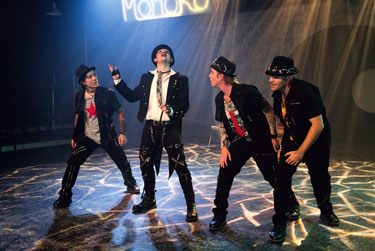Anthony Burgess came to loathe so intensely the one piece of literature he's best known for, a few years before he died he created a musical adaptation of it.
A Clockwork Orange: The Musical – it just has the ring of farce to it, right?

A Clockwork Orange
(Photo by Robert Bowen)
Of course, Burgess adapted his most famous – and infamous – work not exactly as a musical, but as a ''play with music.'' And the point wasn't to make light of its angst-ridden tale of listless teenagers and intolerable adults – anarchy vs. totalitarianism – but to distinguish it from Stanley Kubrick's incendiary 1971 film adaptation. To this day, when someone mentions A Clockwork Orange, most everyone thinks of Kubrick, not Burgess.
Robert MacNamara has wanted to stage A Clockwork Orange essentially from the moment he co-founded his stalwart theater company Scena – the same year Burgess published his adaptation – in 1987. After decades of waiting in the wilderness, MacNamara's determination has paid off in a gung-ho production, now at the H Street Playhouse, that enhances your impression of the story.
The play, you see, is every bit as confusing and troubling as Kubrick's film – but it also has a clearer resolution. Kubrick based his film on the published American version of Burgess's original story, which inexplicably lopped off the final chapter, in which the story's anti-hero, Alex, sees the errors of his violent ways and verily, of his own free will, works to reform himself. Without this resolution, the film leaves one feeling a bit hopeless about society's malcontents – and about government. By contrast, the play helps one keep some sense of faith in humanity and authority.
And while the play outlines the same wanton violence – and violent sex – as the film, it's certainly not as graphic or as glorifying as Kubrick's version. To be sure the violence colors our image of Alex – and of the authorities. But it doesn't paint over the larger picture. The play allows us to see the story's shades of gray. Neither Alex nor the crime-fighting authorities are all bad, all the time.
Chris Stinson plays the role of Alex with particular zeal, blinding the audience, to say nothing of his friends and partners-in-crime – in Burgess's parlance, ''droogs'' – with his boyish charm, to the point it becomes too easy to overlook his many transgressions. We don't like what he does, you could say, but we sure like how he does it. The character of Alex is in nearly every scene, and over the course of the play conveys pretty much every emotion known to man. Because he pulls it off with such ease, it's hard not to think there are far bigger things to come for stage newcomer Stinson, whose lead credit until now was starring in this year's award-winning Capital Fringe show We Tiresias.
But this is not just The Chris Stinson Show. MacNamara has lined up a strong cast of 16 actors capable of being good and bad almost simultaneously, working to tease out the nuances in Burgess's story. Mitchell Grant, Chris Aldrich and Armand Sindoni all serve as effective foils as Alex's lead droogs, in addition to the various secondary roles each assumes. Every scene is also a little bit more amusing with Charlotte Akin in it, whether she's squirming around in an itty-bitty costume as an older dancer at the Milk Bar club or portraying an impeccably suited, stiff-upper-lipped governor. Akin seems to be taking as much glee in her outlandish attire as costume designer Alisa Mandel obviously did in creating her spectacles. Another highlight is Michael Miyazaki as a pudgy but light-on-his-feet prison chaplain, who curses and blesses prisoners in the same breath. Miyazaki commendably takes great pain to keep his portrayal from veering into stereotype – which, as a result, makes it that much funnier.
Paul Gallagher also deserves credit for his stylized fight choreography, which makes you look forward to the violent scenes rather than flinch from them. Marianne Meadows, on the other hand, occasionally overdoes it with stage lighting – totally killing them here, randomly spotlighting them there – leaving viewers disoriented during a scene or two in which nothing of consequence happens.
Scena doesn't employ a band for this production, instead relying on recordings directed by Gregory J. Watkins and sounds from Eric Trester, who keeps up a steady, ominous bass hum throughout many of the play's nonmusical scenes.
By adapting his play to incorporate music, Burgess was also signaling that he wanted to be remembered as a composer. Before he wrote novels and plays, Burgess was a musical director in the British army. Beethoven, of course, is the patron saint of A Clockwork Orange – even the largely forgettable music Burgess composed for the play riffs off Ludwig van. As bombastic as it is, Beethoven's music is generally thought in today's world to be pleasing or, at least, positively stirring. But in A Clockwork Orange it's nearly as intimidating and downright dangerous as the heaviest of heavy metal.
A Clockwork Orange


 To Nov. 18 H Street Playhouse 1365 H St. NE $25 to $30 703-683-2824 scenatheater.org
To Nov. 18 H Street Playhouse 1365 H St. NE $25 to $30 703-683-2824 scenatheater.org
Burgess called music a ''purer art'' than writing because of its objective nature, and yet one of the things most interesting about his tale is how he twists music to become oppressive, even subjective. Beethoven is the fuel – along with drug-fortified milk at Milk Bar, natch – for Alex's ''ultra-violence,'' and it's also the weapon used by the state in attempting to convert criminals like Alex to be good.
That's in large part why Burgess's A Clockwork Orange remains so troubling. Nothing is purely good in this world – not even classical music.
...more